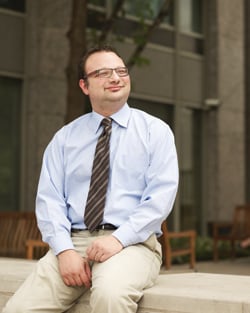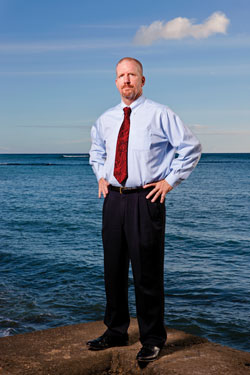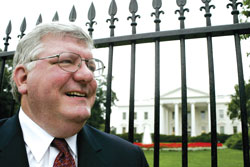Prison Break: Budget Crises Drive Reform, But Private Jails Press On

Illustration by Eddie Guy
Some saw deviltry in the details of a letter (PDF) the Corrections Corporation of America sent to the heads of state corrections departments in January, offering to buy prisons rather than run them for hire.
Just two weeks earlier, the CCA—the largest company in the nation’s private prison industry—had made the first-ever outright purchase of a state penitentiary. Now it wanted more, striking while the leg-iron was hot. Until that sale, for more than three decades various for-profit incarceration businesses had only contracted to run state and local lockups or built new private ones themselves. The CCA poured $72.7 million into Ohio’s cash-starved coffers to buy the Lake Erie Correctional Institution.
Then the CCA dangled $250 million in front of officials in other states agonizing over how to squeeze dollars from dirt in a down economy. In return for sacks of cash, the company wants 20- to 30-year contracts for housing criminals. And the already controversial full privatization also requires states to grind out convictions and sentences for two or three decades at today’s pace and severity, maintaining a guaranteed 90 percent occupancy rate—calibrating the wheels of justice to fit a profit-margin spreadsheet.
But that near-no-vacancy sign might prove difficult to lock in. In each of the past three years, overall population in state prisons has declined a bit—dropping for the first time since 1972, when tough-on-crime policies gained traction. Some states are closing prisons, while others have decided not to build facilities already planned.
That is largely because more and more states are seeking alternatives to what had become lock ’em up and throw open the wallet. They are finding some early success. “Back in the 1980s, we couldn’t talk about criminal justice without mentioning the broken-windows theory, and now that’s happening with mass incarceration,” says Todd Clear, dean of the School of Criminal Justice at Rutgers University. “It’s not just the research and findings, but the fact that the discussion is happening. Something fundamental has changed.”
Where two or more decades of ethical, moral and evidence-based reasoning failed, pinched purses of the public fisc are driving change. The states spend more than $50 billion a year on corrections, according to the Pew Center on the States. Now they’re being forced to get smart on crime. Simply being tough is a luxury.
The U.S., which puts a greater percentage of its citizens behind bars than do China, Russia, Iran and others considered draconian when it comes to criminal justice, might even lose its perch as the world’s leader at incarceration. Not only do we incarcerate more of our citizens; they’re staying in longer. Prisoners released in 2009 had spent an average of nine months longer behind bars than those let out in 1990, according to a study by the Pew Public Safety Performance Project (PDF). “Some nonviolent offenders serve 40 or more years,” Clear says. “That’s insane.”

“Back in the 1980s, we couldn’t talk about criminal justice without mentioning the broken-windows theory, and now that’s happening with mass incarceration,” says Todd Clear, dean of the Rutgers School of Criminal Justice. Photo by Len Irish.
PRIVATE POWER
The private incarceration business remains a relatively small (though powerful) interest, housing about 7 percent of state prisoners and slightly more than 16 percent of federal ones. The numbers and percentages took off in the 1990s with tougher laws and federal subsidies for state prisons before entering a business-model and scandal-fueled tailspin late in the decade. They picked up again and increased by more than a third in state prisons during the 2000s, with even greater growth on the federal side thanks to immigration enforcement after 9/11. The two largest companies, the Corrections Corporation of America and the Geo Group, reported combined revenues of $2.9 billion in 2010. The CCA houses about 80,000 prisoners. Of the more than 60 facilities it operates, it owns 44.
Private prison operators have spent tens of millions of dollars for lobbying and campaign contributions in the past three decades. Besides ongoing state efforts, the CCA spent $23.4 million to lobby the U.S. Congress and several federal agencies over the nine years from 2003 to 2011, coinciding with increased immigration enforcement and detentions. Last year, the CCA received $208 million from contracts with U.S. Immigration and Customs Enforcement, and the Geo Group (formerly Wackenhut Corrections Corp.) got $216 million.
What the CCA wants to purchase in the states with its “corrections investment initiative,” says Judith Greene, director of the nonprofit Justice Strategies, “is another way to sustain its once-again-threatened business model. They need more than the bailout from immigration detentions.” Greene’s group researches and advocates for reform in correction and sentencing law and policy. A number of studies have shown private prisons bring little or no cost savings, and their profit margins depend mostly on spending less for the biggest business cost—personnel. That means paying less for prison guards, already an extremely low-paying occupation. One result is high turnover and the incompetence that inexperience brings, Greene says. And that has sometimes been a recipe for disasters like prison breaks or prisoner abuse. CCA spokesman Steve Owen says the company is just “one tool in the toolbox for decision-makers meeting criminal justice needs.”
“The pendulum swings back and forth going back decades, sometimes with more emphasis on hard-bed incarceration and then back to more community justice alternative solutions,” Owens adds. “There is no one silver-bullet solution.” Just the same, Damon Hininger, CCA president and CEO, was clearly energized during an earnings-call teleconference in November 2011 with analysts, investors and reporters after the Ohio deal was set: “We are excited about our prospects on replicating this type of innovative solution with other state and local governments in this difficult fiscal environment.” Hininger pointed out that states were in the fourth straight year of deficit spending. But the CCA has been less upbeat in its annual 10-K filings with the Securities and Exchange Commission. The 2011 iteration repeated the past few in saying the company could be hurt by new developments in criminal justice such as “the relaxation of enforcement efforts, leniency in conviction or parole standards and sentencing practices, or through the decriminalization of certain activities.”
LOSING FRIENDS
That trend in criminal justice has hurt the industry’s relationships with some of its friends. Beginning in 2009, the American Legislative Exchange Council, which brings together conservative lawmakers and membership-and-fee-paying corporate sponsors in a mini-legislature to develop “model bills,” suddenly abandoned its decades-long support of private prisons. ALEC has been crippled this year by the loss of corporate donors in the wake of criticism for promoting “stand your ground” laws, which came under fire after a Florida teen was shot and killed by a volunteer neighborhood watch member. In the mid- to late 1990s, ALEC pushed model bills for truth-in-sentencing provisions requiring inmates to serve no less than 85 percent of a prison term, and for three-strikes laws and other tough-on-crime measures that were enacted in many states and played a major role in filling and overfilling prisons.
In what would be its last big push for increased incarceration, ALEC adopted a model bill in late 2009 that within months became Arizona’s SB 1070, which brought harsh state action against illegal immigrants. The U.S. Supreme Court knocked down most of the statute in June as being pre-empted by federal law.
As the CCA’s senior director of business development, Laurie Shanblum was a member of the ALEC task force that produced that model bill. She was its private sector co-chair—an agenda-setting role, according to ALEC documents. The CCA was active on that task force when the organization developed legislative models that would significantly increase incarceration.
Corrections Corporation of America spokesman Owen says the company has never promoted criminal legislation, including within ALEC: “It was always, in my recollection, a passive membership that permitted our representative to observe dialogue by decision-makers.”
But once ALEC had firmly embraced initiatives to lower incarceration rates, the CCA soon quit the organization, in 2010. The company would have severed ties earlier but had prepaid for the year, Owen says, noting that with digital, online information it is now easy to “track and monitor trends” without being involved in ALEC.

Marc Levin, who directs the justice initiatives at the Texas Public Policy Foundation, is in the forefront of conservative efforts at criminal justice reform that have gained traction in many states. Two exceptions are Florida and Arizona: “Both give basically no parole and they adopted truth in sentencing for even nonviolent drug possession.” That, in his view, “puts corrections costs and prison population increases on autopilot.” Photo by Jay B. Sauceda.
NEW DIRECTIONS
In addition to the rub of ALEC’s redirected criminal justice priorities, other longtime private prison advocates now question the CCA’s call for a 90 percent occupancy rate in prison purchases. They include libertarians and free-market apostles who embraced the Reagan administration’s revolutionary drives for both privatization of government products and services as well as increasingly harsh laws. “Clearly it would be a very bad public policy and tie the hands of public officials,” says Marc Levin, who runs the justice initiatives at the Texas Public Policy Foundation, a libertarian think tank that added incarceration to its agenda in 2005. “I’m sure Marriott hotels would like a government guarantee for a 90 percent occupancy rate.”
Levin has written favorably of the private prison industry and he still feels that way, as long as proper incentives and goal-oriented outcomes are involved. (He mentions England’s experiment linking private prisons’ remuneration to reduced recidivism.) But he has become a leader in the movement against overincarceration. Beginning in 2007, Levin’s foundation was instrumental in a push that put Texas, long known for being one of the states hardest on crime, at the forefront of criminal justice reform.
He ticks off a list of results like a refrain: a 9 percent drop in the incarceration rate (closing one prison and maybe more soon); a 10 percent drop in the crime rate; and a huge drop in expenditures, with $241 million appropriated the first two years for treating mental illness and substance abuse, and for drug courts and other alternatives to incarceration, rather than appropriating $2 billion for more prison beds over the next five years.
Much of this has come with little or no change in sentencing law—a very deliberate strategy by reformers. Even Levin’s initial writings for the foundation carefully began with concern for victims’ rights before gently segueing to the problem of overincarceration. Seeking to lessen tough-on-crime policies carries the risk of being tagged soft on crime, which can be fatal for organizations dependent on private funding and politicians subject to election.
Levin is quick to point out that the foundation hasn’t pushed for reduced sentences, though that has happened for some nonviolent, drug-related crimes. For the most part, existing but long-underfunded alternatives to incarceration have been key. For example, Texas had many parole-eligible prisoners trapped by lengthy waiting lists for mandatory treatment programs and halfway houses. Additional resources for drug and mental health issues, as well as alternative housing for those prisoners without families, have allowed them to be released. Those additional resources have also made probation and parole programs more effective at lessening a horrific recidivism rate, especially by lowering caseloads for swamped probation officers.
Probation reform offers perhaps the biggest bang for the buck. About two-thirds of those on parole and probation end up back behind bars, most for accumulating small infractions such as missed meetings and failed drug tests rather than new crimes.
The new “best practice” turns out to be a firm-parenting style of reform developed in 2004 by Steve Alm, a state judge in Hawaii. The change has resulted in an 80 percent drop in positive drug tests and an equally significant drop in recidivism there. But the program takes a lot more effort and manpower. Rather than let small problems pile up, closely monitored probationers receive immediate punishment, usually a brief stint in jail. According to Alm, the Hawaii model known as HOPE, or Hawaii’s Opportunity Probation Enforcement, has been implemented in Alaska, Arizona, Indiana, Missouri and Washington, and is being set up in certain cities in Arkansas, Massachusetts, Oregon and Texas. The U.S. Department of Justice also is experimenting with HOPE. Alm, a Honolulu First Circuit Court judge, says he created the program out of frustration with the repetition of failure in probation. “This is Parenting 101, Personal Responsibility 101,” Alm says. “One reason it works is because even the offenders think it’s fair. They used to go along with infraction piling on top of infraction, over and over with no consequences. Now there is some jail every time, though it’s brief—it is swift, certain and proportionate. They get it.”
While the powerful simplicity of Alm’s narrowly tailored innovation is catching on in some states, others have also been adopting significant reform measures, including Arkansas, Georgia, Kentucky, Michigan, Missouri, New Jersey, New York, Ohio, Oregon and South Carolina. But there are bumps in the road. Kansas, for instance, saw quick results after adding resources to probation and other community efforts in 2007: a 61 percent success rate for probation in 2008 (compared to 46 percent two years earlier) and a 6 percent drop in prison population. But in 2009’s weakened economy, budget cuts hit those programs hard and the trends reversed. And last year North Carolina enacted the Justice Re-investment Act, which would include closer supervision in probation and parole and more treatment programs. But the legislature didn’t fund it, leaving state Department of Public Safety officials bewildered.

Hawaii Judge Steve Alm’s highly successful probation reform program has been implemented in several states. “One reason it works is because even the offenders think it’s fair. They used to go along with infraction piling on top of infraction, over and over with no consequences. Now there is some jail every time, though it’s brief—it is swift, certain and proportionate. They get it.” Photo by Marco Garcia.
NO JAIL FOR MORE
A major point in such legislation is to save even more money by lowering incarceration rates. Prisons account, on average, for 88 percent of state corrections budgets. Prisons have become expensive warehouses where all that matters is time served. One result has been to produce, on average, even more hardened criminals as nonviolent offenders turn into violent ones, especially when returned to the streets abruptly and with little or no training, counseling or bonds to the community.
“We say, ‘Distinguish between those we’re mad at and those we’re afraid of,’ ” says Levin of the Texas Public Policy Foundation.
After working on such issues with other free-market think tanks in the State Policy Network, Levin realized many of their efforts were similar, isolated and ad hoc. In December 2010, he and others launched the coalition Right on Crime. They seek to reclaim criminal justice policy with conservative solutions, admitting their tough-on-crime policies had been counterproductive, though in reaction to what they believe were misguided ones wrought by liberals.
The foundation on which ROC sits is a statement of principles that includes incentives for both inmates and the corrections system. But what gives the document gravitas is its list of signatories, 51 high-profile conservatives, most of whose names have long been synonymous with “tough on crime”: former Attorney General Edwin Meese; former drug czar William Bennett; Newt Gingrich; former American Conservative Union chairman David Keene; Richard Viguerie, a conservative movement godfather; and the no-tax-hike-pledge guru Grover Norquist, among others.
“It really helps us when working on these reforms in the states,” says Pat Nolan, director of the Justice Fellowship, which seeks legislative reform of criminal justice policy. The organization is an arm of the Prison Fellowship, the outreach ministry created by Charles Colson after serving time for his role in the Watergate scandal.
“I used to call Ed Meese or Bill Bennett or some others, time after time, to get them to call individual legislators in support of bills, but now we can just point to the statement of principles and the names behind it,” says Nolan, who had been the Republican leader in the California State Assembly until he was caught accepting illegal campaign contributions. He went to prison in the mid-1990s, where he would follow Colson’s faith-based, redemptive path. Nolan developed the list of big-name conservatives, and he is on it. “The legislators see they’re not alone and supporting oddball aberrations, but are part of the mainstream conservative movement.”
Even those on the liberal side give props to ROC for speeding up and spreading reform. Criminal justice has become significantly bipartisan at a time when so much else on the public agenda falls into a deep political gorge.
“Pat Nolan and others deserve an awful lot of credit,” says Marc Mauer, executive director of the Sentencing Project, which for 26 years has advocated for sentencing and incarceration reform. “They’re providing a different comfort level for mainstream or conservative lawmakers, letting them know that it’s OK to buy into some of this stuff.”
But ROC’s imprimatur hasn’t been enough to overcome some setbacks. After several hundred inmates gained early release under a new New Jersey law in 2011, two of them committed murders. Even without the new policy, they would have been on the streets just weeks or months later, and the program’s overall statistics were quite good.
Still, New Jersey Gov. Chris Christie used the flap as an opportunity to call out a political rival who had sponsored the legislation, saying she contributed to the murders. The legislature promptly repealed the law. “We know that staying a few more weeks or months in prison won’t change you for the good,” says Rutgers’ Clear. “And somehow prison itself is never held accountable for what people do after they leave.”

“I used to call Ed Meese or Bill Bennett or some others, time after time, to get them to call individual legislators in support of bills, but now we can just point to the statement of principles and the names behind it,” Pat Nolan, director of the Justice Fellowship. Photo courtesy of Justice Fellowship.
REFORM RISES …
Despite bumps in the road, incarceration reform is gaining momentum.
Bill Shepherd, the ABA Criminal Justice Section chair, was once Florida’s statewide prosecutor, heading eight offices concerned largely with criminal networks, including gangs. He is now a leader in ABA efforts to help states develop reforms.
The section, along with other ABA entities, is promoting five detailed proposals for legislators: pretrial release, decriminalization of minor offenses, effective re-entry programs, community corrections programs, and increased use of parole and probation.
Sweeping reform is also under way in California, though not wholly by choice. Voter initiatives scheduled for this fall would significantly curtail the state’s onerous three-strikes sentencing law and abolish the death penalty, an expensive venture for any state, especially a large one.
But perhaps the most interesting and promising reform effort in the country is California’s response to a federal court-ordered release of 30,000 inmates over the next two years because of prison overcrowding. California had the highest number of state prisoners in the country and is in the process of releasing 20 percent of them.
Among a number of tactics, such as increased parole and earned time-reduction credits, the most novel and closely watched was pushed by Gov. Jerry Brown. In October 2011, under the Criminal Justice Realignment Act, the state turned responsibility for certain prisoners not convicted of sex offenses or violent crime back to the localities that convicted them.
Those criminals will no longer be housed in state facilities. The localities get some (but not much) money from the state to deal with the changes, and it is up to them to decide between alternatives to incarceration and building new jails.

Kyrsten Sinema, a Phoenix Democrat who spent seven years in Arizona’s legislature before resigning to run for Congress this year, takes issue with the state’s decision to steer foreclosure settlement funds to private prisons. Photo by Len Irish.
… BUT NOT EVERYWHERE
Still, two states are notable for continuing with lock-’em-up approaches that burden budgets. “Florida and Arizona have been stubborn,” says Levin, whose libertarian-backed reforms in Texas were rebuffed when broached in Arizona. “They have some commonalities: Both give basically no parole and they adopted truth in sentencing for even nonviolent drug possession—without parole. That puts corrections costs and prison population increases on autopilot.”
Earlier this year, a bipartisan legislative effort in Florida stopped a fast-track push to put 27 of its prisons into what would be the largest single-state private prison network in the nation. The effort seemed teed up for the Geo Group, a Florida-based company and the CCA’s main competitor. (The state already is one of a handful that account for most of the nation’s private-prison business.)
At the same time, Florida moved to tighten its corrections belt, with the legislature recommending cuts that would include the loss of 256 probation officer positions.
Arizona is something else entirely. Facing serious budget problems in 2009, the state tried putting its full faith in saving money through privatized incarceration—a promise its own studies have discounted. That September, Gov. Jan Brewer signed a law that would have made up to nine of the state’s 10 prison complexes privately run. It was repealed with less fanfare in March 2010 because of concerns about the ability of private prison companies to run maximum security facilities. But the state remains undeterred in its belief in more prisoners and more prisons, especially those run privately. In May the legislature passed a budget that contained a provision eliminating “the requirement for a quality and cost review of private prison contracts.” Until then, private prisons had to cost less and provide more.
“They zeroed it out of the budget so that it can’t happen,” says Kyrsten Sinema, a Phoenix Democrat who spent seven years in Arizona’s legislature before resigning in January to run for the U.S. Congress. “But even when it was required they didn’t do it. So there were no annual quality and cost reviews being done anyway.”
Shortly before the legislative move, the American Friends Service Committee, a Quaker group focused on criminal justice reform, released a study (PDF) indicating Arizona’s cost for private prison beds between 2008 and 2010 was $10 million greater than it would have been with public facilities.
Arizona’s expensive overincarceration problem has been fed in part by highly symbolic policies concerning clemency and pardons. Brewer is not only setting a modern record for the fewest grants of clemency; in April she replaced three of the five members of the clemency board after its unanimous recommendation to free a model prisoner whose mandatory sentence had been called “excessively harsh” even by the judge handling the matter. And at a time when most budget items have been slashed in Arizona, money for corrections continues to increase. When the state received nearly $98 million in a settlement with several financial institutions for foreclosure abuses, $50 million was diverted to the general fund. Coincidentally, the budget calls for spending $50 million to develop another 500 maximum-security prison beds and twice that many in private prisons.
“They took that money and put it in private prisons,” Sinema says. “It was supposed to be dedicated to foreclosure prevention.” Arizona has suffered one of the nation’s highest foreclosure rates.
Things are somewhat different in Louisiana, where legislators have rebuffed Gov. Bobby Jindal for the past two years when he tried to sell state prisons to private-prison companies in order to pump tens of millions of dollars into the shrinking revenue stream. Louisiana has the distinction of incarcerating the highest percentage of its population of any state, and thus is the leader in a nation that holds the same record worldwide. Sheriffs running local prisons fatten their own budgets with per diems from the state for prisoners they hold. According to an in-depth series earlier this year by New Orleans’ Times-Picayune, about half of Louisiana’s inmates are in local prisons, including private ones—a far higher percentage than in other states—while local sheriffs and the private prison industry are hauling in $182 million a year to operate them.
But when Jindal made a bid to sell some prisons outright, Louisiana Treasurer John Kennedy likened the governor to “a junkie selling the television set and radio to generate money for his next fix.”
OPENING THE CELLS
Few think the lock-’em-up approach is sustainable for much longer. The incarceration reform movement seems inexorable, despite concerns that if the economy continues to stall, U.S. legal systems will find more reasons and ways to put people behind bars—or that if flush times return, we will be able to afford ever-growing prison populations.
But no matter how much the economy might recover, battles will only increase over funding for education, crumbling infrastructure, various entitlement programs, outlays for medical care and more on a list of social priorities likely to eclipse the need to lock up those with whom we might be angry, but who otherwise don’t pose much threat.
“These things are enormously expensive and people care about them a great deal,” says Clear, the Rutgers criminology dean. “It used to be that in surveys of what people are concerned about, crime would be No. 1, 2 or 3. Now it’s not in the top 10, and hasn’t been for 15 years.
“I believe this change will have some legs,” Clear says. He’s been nudging it for three decades and is more hopeful than some colleagues. “History will show that the mass incarceration era has ended.”



